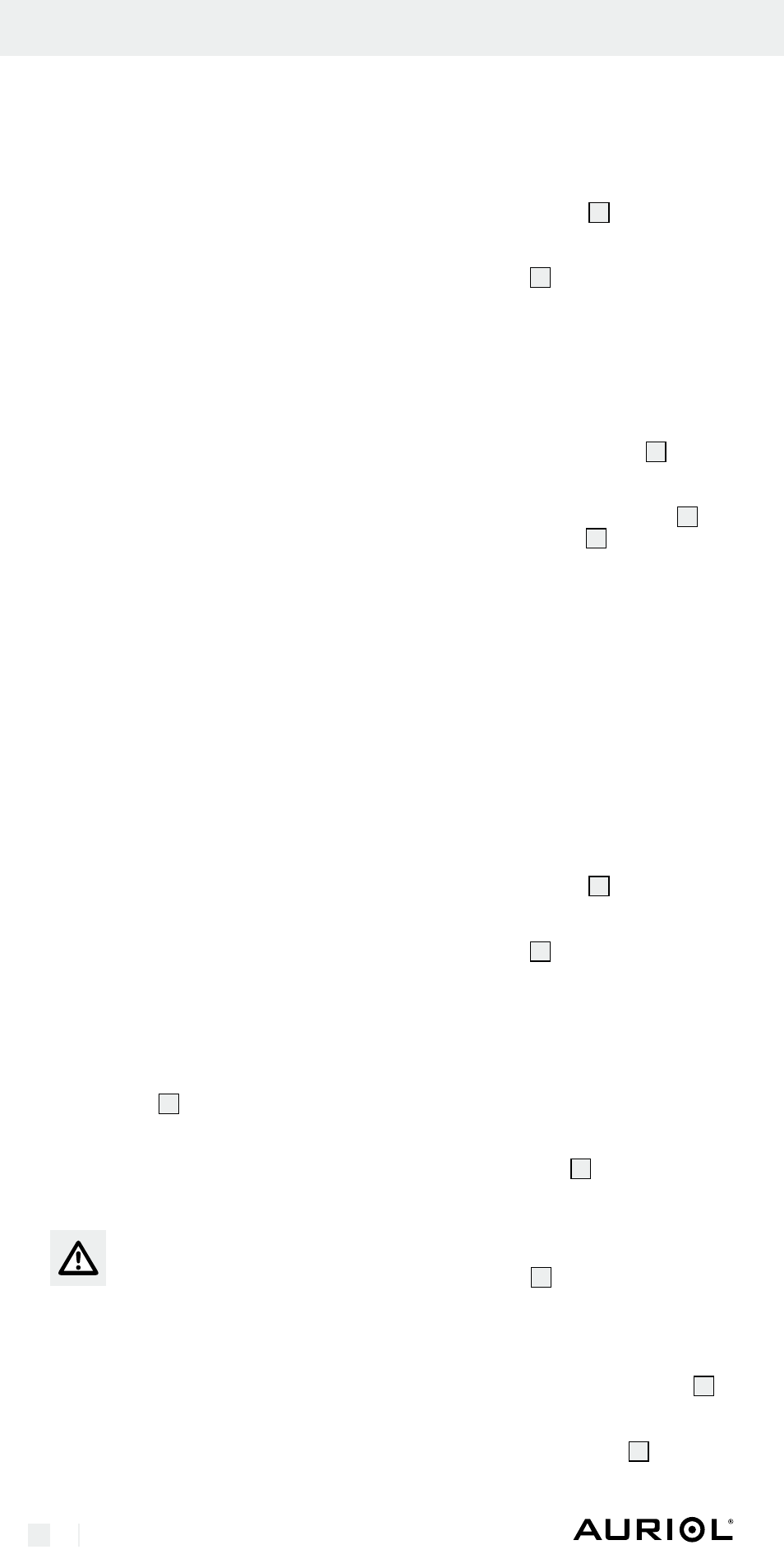Before initial use, Putting the outdoor sensor into operation, Putting the weather station into operation – Auriol Z29536 User Manual
Page 38

38 GB/MT
Before Initial Use
j
Do not place the devices near sources of in-
terference such as television sets, computers,
thick walls, thermopane windows etc. Other-
wise the transmission of radio waves between
the devices may be impaired.
j
Please install the devices at least 2 metres
away from sources of interference. Otherwise
the transmission of radio waves between the
devices may be severely impaired.
j
Please ensure that neighbouring devices are not
operated at the same frequency of 433 MHz.
Such devices may cause interference to the
radio connection.
j
Do not place the devices next to or on metal
plates. Otherwise the quality of radio wave
transmission may be reduced.
j
Do not install the devices in buildings made
of reinforced concrete, e.g. airports, high-rise
buildings, factories or cellars. Otherwise the
transmission of the radio waves between the
devices may be severely impaired.
j
Do not start reception of the waves in a moving
vehicle, e.g. car or train. The transmission of
the radio waves to the devices may interfere
with the electronics of the vehicles.
j
In open spaces do not place the devices more
than 25 metres apart, as otherwise transmission
of the radio waves may be interrupted.
j
Do not expose the devices to temperatures
below –20 °C for prolonged periods, as
otherwise this will adversely affect the trans-
mission range.
Q
Putting the Outdoor
Sensor into Operation
removing the battery safety strip:
note: For this procedure you need a flat-blade
screwdriver.
j
Open the battery compartment cover on the
rear of the outdoor sensor by turning the
screw in an anticlockwise direction with the
flat-blade screwdriver.
j
Remove the battery safety strip. The outdoor
sensor is now ready for operation and the
control LED
36
lights up briefly.
j
Close the battery compartment cover and
tighten the screw in a clockwise direction.
Installing the Outdoor Sensor:
note: For this step you need a drill.
cAUtIOn! DAnGEr OF DEAtH
AnD InJUrY AnD DAnGEr OF
MAtErIAL DAMAGE! Please read
the operating and safety instructions of your drill
through carefully.
j
Find an appropriate place for the outdoor sensor.
note: Please ensure that you install the
outdoor sensor within a radius of 25 m from
the weather station. Check that there are no
obstacles between the outdoor sensor and
the weather station. Otherwise there may be
interference of the transmission of data.
For wall mounting:
j
Mark the drill hole on the wall.
j
Drill the hole with a drill.
j
Insert a suitable wall plug into the drill hole.
j
Use a screwdriver to insert a suitable screw.
j
Hang the outdoor sensor on the screw with
the wall mounting hole
38
.
For free standing:
j
Turn the stand
43
out from the bottom of the
outdoor sensor.
Q
Putting the Weather
Station into Operation
removing the battery safety strip:
j
Open the battery compartment
34
on the
back of the weather station.
j
Pull out the battery safety strip.
j
Then close the battery compartment
34
.
j
Press the RESET button
33
. All of the symbols
light up briefly.
As soon as the battery safety strip has been
removed, the weather station starts to receive
the radio signal.
note: Do not change the location of the weath-
er station during reception. Otherwise there may
be interference.
For wall mounting:
j
Mark the drill hole on the wall.
j
Drill the hole with a drill.
j
Insert a suitable wall plug into the drill hole.
j
Use a screwdriver to insert a suitable screw.
j
Hang the weather station on the screw with
the wall mounting hole
32
.
For free standing:
j
Turn the stand
35
out from the bottom of the
weather station.
connecting the weather station with the
outdoor sensor and the DcF radio signal:
After removal of the battery safety strip the weather
station attempts to establish a connection with
the outdoor sensor. This process may take a few
minutes. When the connection with the outdoor
sensor has been successfully established, the
selected channel symbol
22
is shown the channel
of the outdoor sensor (To change the channel of
the sensor, see “Setting the channel”). If the con-
nection with the outdoor sensor is not established
automatically, this can be done manually by
pressing TX button
42
of the sensor”.
As soon as the weather station has established a
connection with the outdoor sensor it automatically
begins to receive the DCF radio signal. This proce-
dure takes a few minutes and is shown in the LC
display by the flashing radio tower symbol
18
.
When the DCF radio signal is being successfully
received, the radio tower symbol
18
is shown
permanently in the display. If at the time of putting
the device into operation it is not possible to syn-